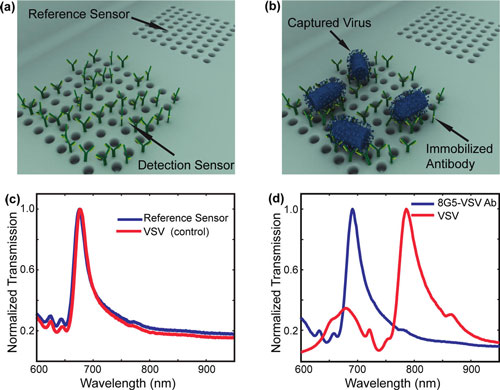Nanowerk Spotlight) In physics, a plasmon is the quasiparticle resulting from the quantization of plasma oscillations just as photons and phonons are quantizations of light and sound waves, respectively. As the name indicates, surface plasmons are those plasmons that are confined to surfaces. Controlling these surface plasmons has become a 'hot' research area for optical signal processing, surface enhanced spectroscopy and sensor nanotechnology.
Our work is the first demonstration of detection of intact viruses using extraordinary light transmission phenomena in plasmonic nanohole arrays," Altug tells Nanowerk. "So far, questions remain regarding the possible limitations of this technique for virus detection, as the penetration depth of the surface plasmon polaritons (SPP) is comparable to the dimensions of the pathogens.
Altug explains that their sensors exploit plasmonic resonances supported by plasmonic nanohole arrays (PNA) for detection. PNAs are arrays of nanoscale apertures (holes, with diameters of ∼250-350 nm) that are defined periodically (with pitch ∼500-800 nm) on an optically thick noble metal films such as ∼100 nm thick gold. At certain wavelengths, these nanohole arrays can transmit light much more strongly than the classical aperture theory predicts. [ This phenomenon is called extraordinary optical transmission (EOT) effect.
http://en.wikipedia.org/wiki/Extraordin ... ansmission ]
EOT signals result from the involvement of surface plasmon-polariton resonances (SPR). The resonance wavelength of EOT signal is strongly correlated with the effective dielectric constant of the adjacent medium around the plasmonic sensor. Altug explains that, as pathogens bind to the sensor surface, the effective refractive index of the medium increases, and the red-shifting of the plasmonic resonance occurs.

http://www.nanowerk.com/spotlight/spotid=19047.php



